Displaying items by tag: Chris O'Dowd
Shannon Cruising On 'The Moone Boy Trail' Through Leitrim & Roscommon
Exploring the Shannon by boat with a Carrickcraft three-day cruiser hire was not the first choice for David O'Brien and family's September weekend getaway. But North Roscommon gave a lot more than expected
With the summer ebbing away, my family were in need of a short holiday, but we had grown so tired of no–care airlines that even the prospect of the Aircoach was beginning to make it more like a chore than a well-earned break. There must be some other way to spend quality family time without the queues, we thought.
What's more, I was determined to show my family, comprising of my wife Lisa and children Isabel (15) and Thomas (13), that Ireland could offer much more than the usual format of the so-called 'city break'.
 Far away fields are always greener – but the prospect of 'Please arrive three hours early for your flight' and a crowded departures area of Dublin Airport did not inspire us...
Far away fields are always greener – but the prospect of 'Please arrive three hours early for your flight' and a crowded departures area of Dublin Airport did not inspire us...
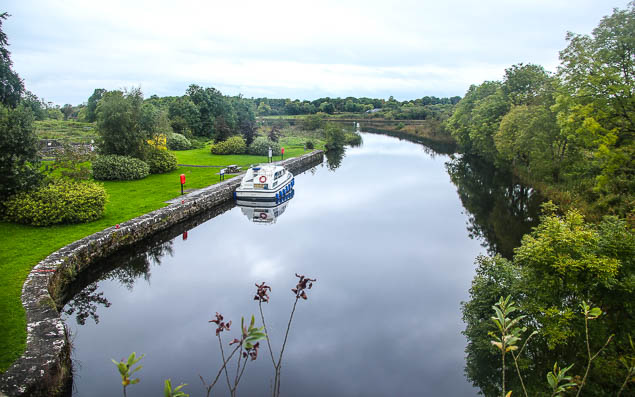 ...so we swapped it for rush hour on the Shannon...
...so we swapped it for rush hour on the Shannon...
I suggested some local options. "How about a River Shannon cruise?"
It was a question that, quite honestly, did get a mixed reaction at the kitchen table. But with an open mind and a sense of adventure it was something they all thought (eventually) would be worthwhile giving a shot.
Plotting the course
The navigable River Shannon runs for 400km but if you've got just three days, where does a novice start?
It might be the essence of leisurely cruising to drift along, going where the river might take you, but that could not be this weekend's plan. In order to satisfy my teenage crew, I felt this had to be exactly the opposite: a 72–hour whistle stop tour packing in as much fun as we could along the way.
But could a 20km stretch in North Roscommon really measure up to a weekend in London, for example?
The county is landlocked, yet there are plenty of lakes to make up for the lack of any coastline. Loughs Key, Allen and Ree are all situated in the county. But more than that, one of the more notable features of Roscommon is the fact it is the home of well-known actor Chris O'Dowd, who grew up in Boyle. He's also a family favourite, as it happens.
 Moone Boy on Sky Two: Chris O'Dowd (left) as Sean Murphy and David Rawle as Martin Moone is a big hit in Boyle. Photo: Sky
Moone Boy on Sky Two: Chris O'Dowd (left) as Sean Murphy and David Rawle as Martin Moone is a big hit in Boyle. Photo: Sky
Experience had taught me it's the simple things that mean the most, so I was sure that if I spent a little time in planning it could go a long way. I decided there were some basic requirements for a successful trip that would provide fun for the family and some nice memories.
First of all, we'd want our weekend to have minimum travel time to the destination. There should be activities for my family to do together, and the chance to learn something new.
There should also be easy access to dining options. They say cooking on board is a Shannon cruise pleasure but we decided against it – it's meant to be a holiday, after all.
And I knew well that if we ended up stranded on the river bank looking at one bag of crisps, with a long walk at dusk to the nearest town, then it would be a short–lived cruise at that.
Carrickcraft is a leading Irish Shannon cruise hire firm that has a base in Carrick-on-Shannon in Co Leitrim. I booked a three-day cruise with a start and finish in Carrick, on board a self-drive Kilkenny Class (4 + 2 Berth) for three nights priced at €765.
In search of 'The Moone Boy Burger'
On the map, Carrick looked like a central enough location, and not too remote. But early research into what we might do when on the water wasn't easy. Certainly, there were guides but not much in terms of joined-up thinking for waterborne tourists.
There were navigation charts. There were route planners. There were restaurant guides. There were activity guides. But what I needed was the nice easy spoonful of an entire travel plan that tied in journey times with berthage, activities with restaurants.
For instance, I spotted that some of the nicest sounding restaurants in Georgina Campbell's invaluable Inland Waterways Restaurant Guide were not always accessible by boat. I just coudn't work out how we could get to a restaurant at dusk and back in the dead of night. Taxis in this neck of the woods can be as rare as river kingfishers. And dark country roads are not pedestrian-friendly.
To make a success of our short break, I had to join the dots between time, food and river, so I ended up making up my own itinerary – an idiot's guide, if you will, to cruising on the River Shannon: the 72–hour edition!
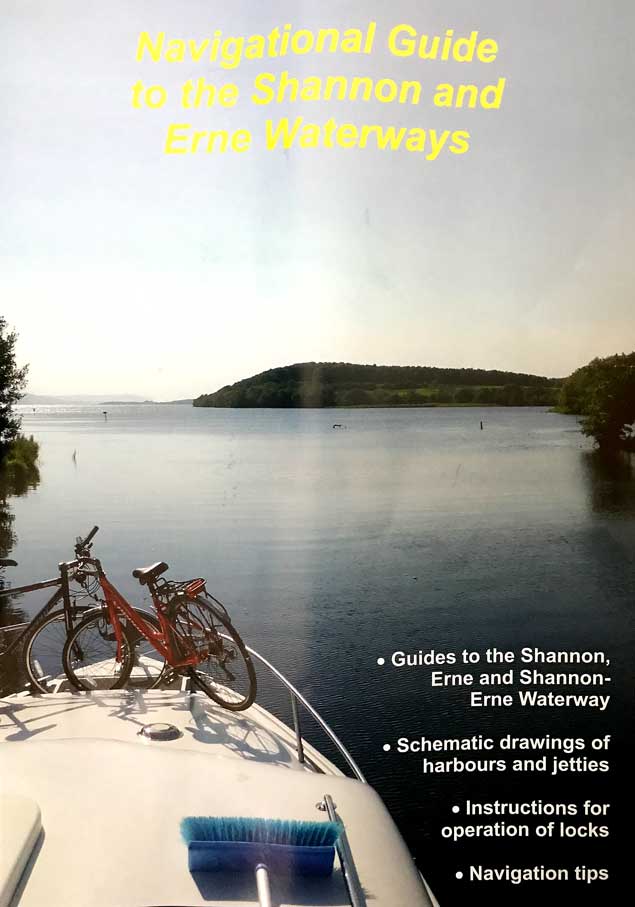 The Navigational Guide to the Shannon is a captain's handbook that charts the river and gives plenty of tips. It has drawings of harbours and jetties and makes it easy to plot your course. You get a copy when you hop on board your cruiser. Courtesy: Shannon Leisure Development Company Ltd
The Navigational Guide to the Shannon is a captain's handbook that charts the river and gives plenty of tips. It has drawings of harbours and jetties and makes it easy to plot your course. You get a copy when you hop on board your cruiser. Courtesy: Shannon Leisure Development Company Ltd
My research time was well spent, though, because within an hour or so I had sketched out a voyage that might involve wildlife, history, literary links, Hollywood stars, gourmet food, navigational tips and exercises, bike trails, high-wire tree-top adventures, castles and islands. But most of all, we would be captains of our own ship of adventure as we steamed up and down the River Shannon, in search of 'The Moone Boy Burger'.
Did we expect to find such weekend adventure and welcomes, just an hour-and-a-half from home? No, we certainly didn't.
Here's how our trip worked out:
Friday – Downstream to Jamestown
12 noon – It's half-day Friday! Collected kids from school and headed straight for the N4. From Dun Laoghaire it's two hours (169.2 km) via the M4 and N4 to Carrick-on-Shannon.
2pm – Check-in at the Carrickcraft base, and meeting our cruiser for the weekend. (Top tip: Park your car near the jetty for handy loading/unloading.)
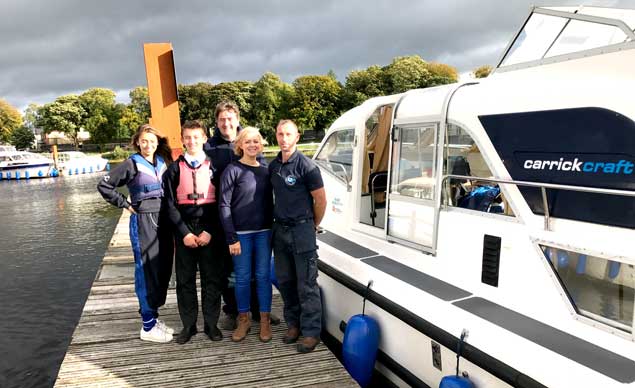 First sight of our weekend home, Carrickcaft's Kilkenny class E22 cruiser. Journey time has been so instant the kids are still in school uniform!
First sight of our weekend home, Carrickcaft's Kilkenny class E22 cruiser. Journey time has been so instant the kids are still in school uniform!
2.30pm – Before we set sail, it's straight to restaurant #1: lunch at the Oarsman!
 Seven generations of proud hospitality keeping in Carrick-on-Shannon. A tradition stretching back to 1870 (above and below), The Oarsman is a fine spot for a fortifying pre-cruise lunch and it's round the corner from Carrickcraft's marina
Seven generations of proud hospitality keeping in Carrick-on-Shannon. A tradition stretching back to 1870 (above and below), The Oarsman is a fine spot for a fortifying pre-cruise lunch and it's round the corner from Carrickcraft's marina
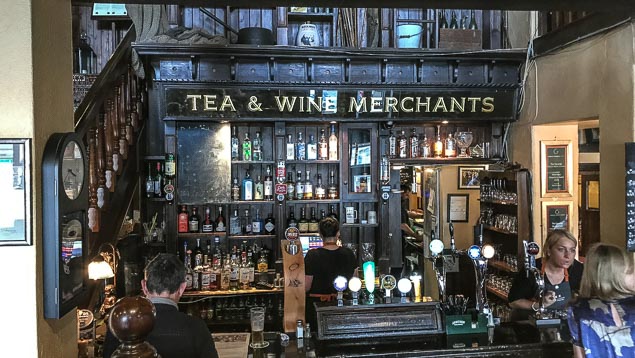
4.30pm – We get an instructional tour of our Kilkenny Class cruiser and a helpful driving test from our Carrickcraft guide, Padraig. And there's a bit to know: If you're reversing, steer left if you want to go right. Gottit?
 Padraig from Carrickcraft gave us a thorough guide of our self-drive cruiser. No experience (or licence) is necessary to rent a cruiser as full training is given
Padraig from Carrickcraft gave us a thorough guide of our self-drive cruiser. No experience (or licence) is necessary to rent a cruiser as full training is given
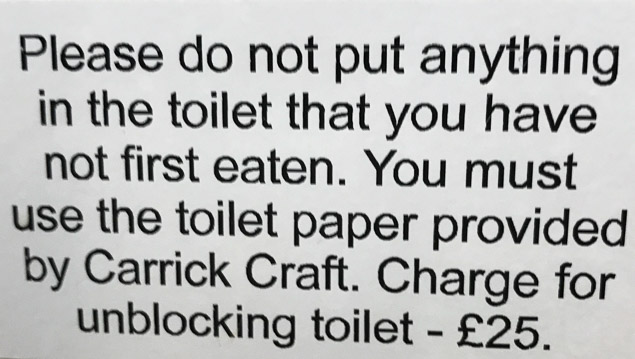 There are rules of the river and also rules onboard. This sign behind the loo made the kids chuckle
There are rules of the river and also rules onboard. This sign behind the loo made the kids chuckle
 This layout plan gives the broad outline of the Kilkenny’s effective accommodation, but the forward cabin is best with no engine noise Illustration: Carrickcraft
This layout plan gives the broad outline of the Kilkenny’s effective accommodation, but the forward cabin is best with no engine noise Illustration: Carrickcraft
5pm – We depart Carrick-on-Shannon and head downstream under the bridge to Jamestown, because restaurant #2 has been booked for at least a fortnight.
 Downstream from Carrick-on-Shannon to our first port of call at Jamestown, both in Co Leitrim, served as a good shake-down on our first evening afloat Courtesy: Shannon Leisure Development Company Ltd
Downstream from Carrick-on-Shannon to our first port of call at Jamestown, both in Co Leitrim, served as a good shake-down on our first evening afloat Courtesy: Shannon Leisure Development Company Ltd
 Navigation for cruisers is not possible downstream of Jamestown
Navigation for cruisers is not possible downstream of Jamestown
 The strong flow is visible on the marker poles
The strong flow is visible on the marker poles
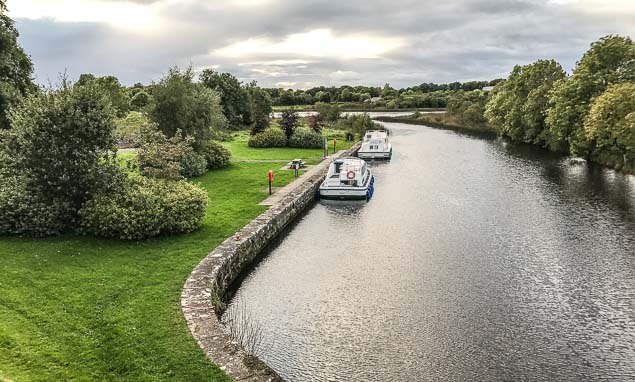 We moored at Ardanaffrin Bridge, on the Jamestown Canal (we're the cruiser nearest the camera). This mooring is round the corner from Jamestown but probably the safest because it's away from a fast-flowing stretch of river at Jamestown Bridge. The village is a pleasant 15–minute walk from here
We moored at Ardanaffrin Bridge, on the Jamestown Canal (we're the cruiser nearest the camera). This mooring is round the corner from Jamestown but probably the safest because it's away from a fast-flowing stretch of river at Jamestown Bridge. The village is a pleasant 15–minute walk from here
6pm – 'Watch out for the strong flow on the river at the end of the navigation.' Whoa, they're not joking! No room at the inn at Jamestown Quay thanks to a couple of what looks like long term harbour hoggers but we find a spot round the corner and berth up for the night on the nearby Jamestown Canal at Ardanaffrin Bridge. Glad of the company of one other cruiser, it feels lovely but a tad isolated.
 On foot – some onboard hi-viz jackets would be handy...
On foot – some onboard hi-viz jackets would be handy...
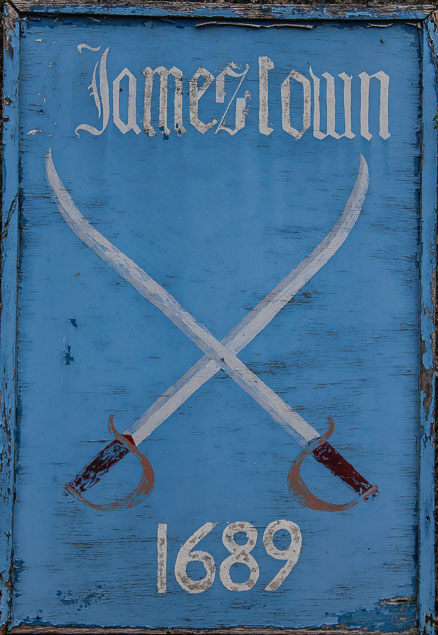 Jamestown used to be on the main Sligo–Dublin road (N4) and was known for the narrow pillars of the arch of the old town gate that straddles the road in the centre of the village
Jamestown used to be on the main Sligo–Dublin road (N4) and was known for the narrow pillars of the arch of the old town gate that straddles the road in the centre of the village
6.20pm – It's Shank's Mare to the village. Just need to remember where we parked the boat for the return journey in the dark! No street lights round here...
6.30pm – It's anicent Ireland time as we pass through the town gates. No wonder Roscommon marketeers use the phrase 'the beating heart of Ireland's past' to describe the place.
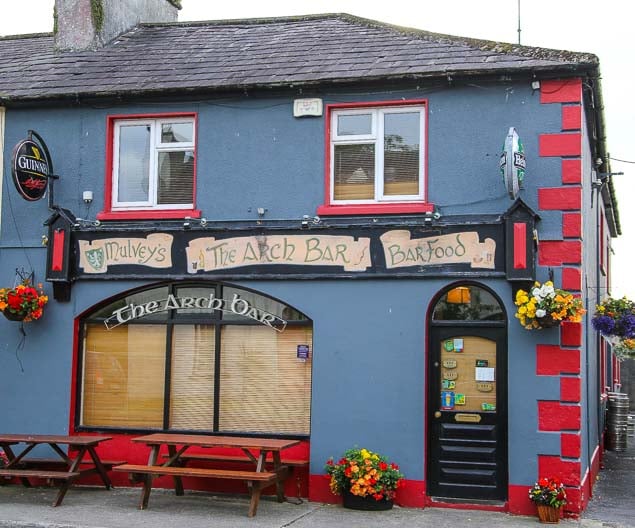 One of Jamestown's two pubs, The Arch Bar
One of Jamestown's two pubs, The Arch Bar
6.40pm – We're at the Arch Bar for pre-dinner pool and pints.
7.10pm – Leitirm's gourmet capital is found in The Cottage, a modestly named and presented restaurant. Inside, a giant portrait of the owner's father sitting astride a giant ox is an early clue that there's more than cottage pie on offer here...
 The Cottage Restaurant. Make sure to book in advance – they come from as far as Sligo to sample this cuisine
The Cottage Restaurant. Make sure to book in advance – they come from as far as Sligo to sample this cuisine

 With starters served in cigar boxes, Chef Sham and manager Lee Hanifa pull out all the stops in a restaurant that uses only locally sourced produce. What a first night treat!
With starters served in cigar boxes, Chef Sham and manager Lee Hanifa pull out all the stops in a restaurant that uses only locally sourced produce. What a first night treat!
10.30pm – Taxi! No Uber or Hailo here. It turns out to be a bit of a wait for Jamestown's only cabbie, CK (Tel: 086 0772020). It's a €7 fare well spent, though, as we avoid walking on some pitch-black switch back roads (no paths, no street lights).
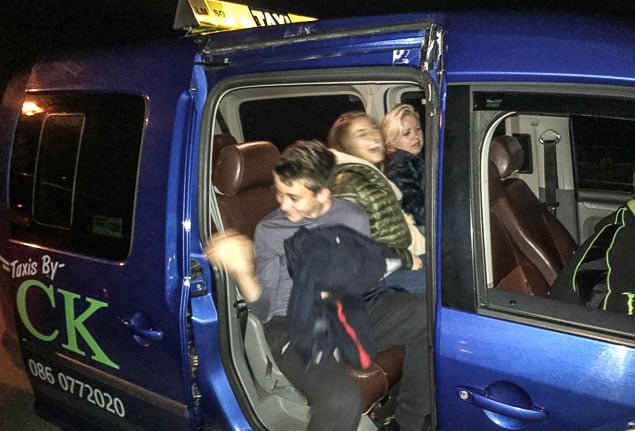 A great night comes to end – CK Taxi is well worth the fare... if you can get him.
A great night comes to end – CK Taxi is well worth the fare... if you can get him.
11pm – Goodnight!
Saturday – Upstream to Lough Key Forest Park and Boyle
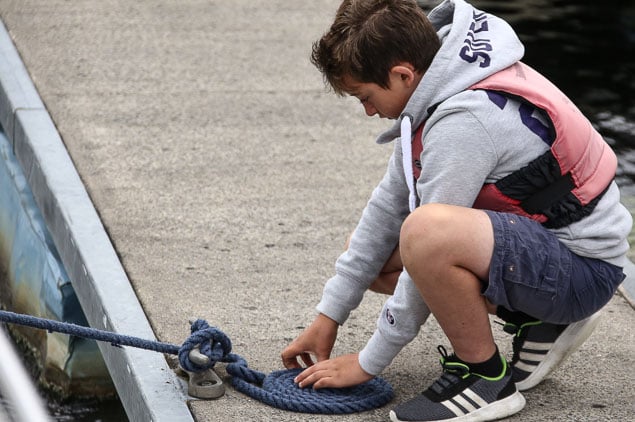 Learning about mooring ropes. Between casting off, steering, navigating and negotiating locks, there are plenty of new skills to learn
Learning about mooring ropes. Between casting off, steering, navigating and negotiating locks, there are plenty of new skills to learn
8am – Good morning! After some early morning reconnaisance on foot, we like the idea of a short detour to explore Jamestown Canal.
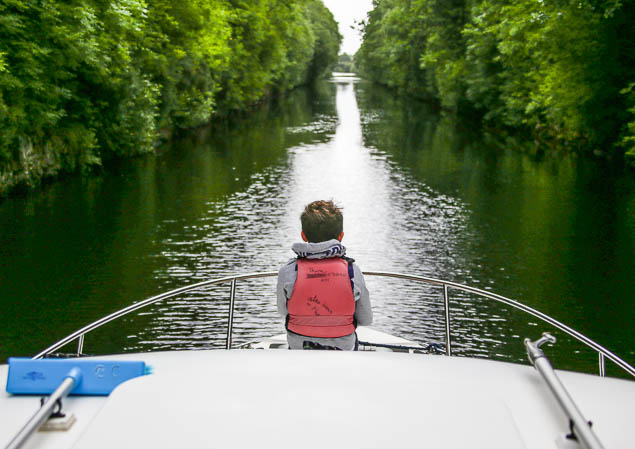
8.40am – It's like stepping back in time. Solitude.
 Although the sign is erected to the memory of a past generation, the canal is relatively new in the context of the Shannon's 5,000-year history
Although the sign is erected to the memory of a past generation, the canal is relatively new in the context of the Shannon's 5,000-year history
8.50am Immersed in this Victorian feat of engineering, it's left to Thomas to ask: "Dad, how are we gonna turn around?"
8.55am We manage a six–point turn. The E22 is pretty manoeuvrable. Phew! And in the process, we catch the unmistakable glimpse of a kingfisher flying alongside us.
9am – Turning back on ourselves, we head upriver on our journey to Lough Key Forest Park.
 We headed back upriver past Carrick and through Lough Eidin into the Boyle River on our way to Lough Key in Co Roscommon, a very manageable voyage of two or three hours in total Courtesy: Shannon Leisure Development Company Ltd
We headed back upriver past Carrick and through Lough Eidin into the Boyle River on our way to Lough Key in Co Roscommon, a very manageable voyage of two or three hours in total Courtesy: Shannon Leisure Development Company Ltd
9.15am – This shower will pass! The heavens open and we're glad we've got umbrellas on the flybridge.
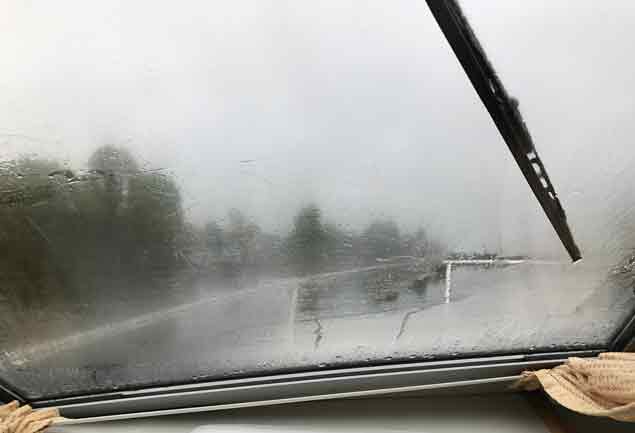 It wasn't all plain sailing....we got some heavy showers
It wasn't all plain sailing....we got some heavy showers
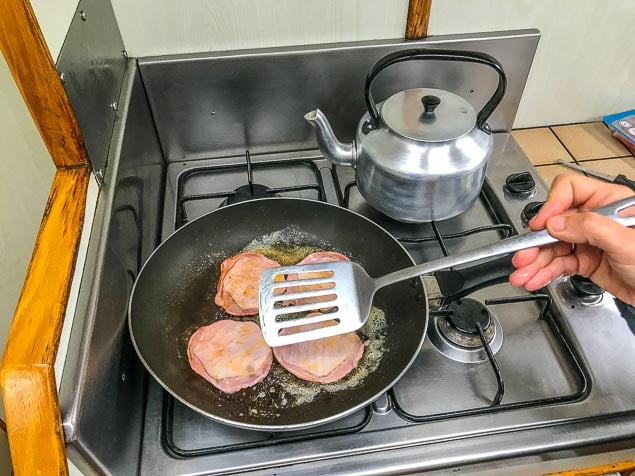 There's a pan and a gas hob that's only waitin' for the kettle and the rashers....
There's a pan and a gas hob that's only waitin' for the kettle and the rashers....
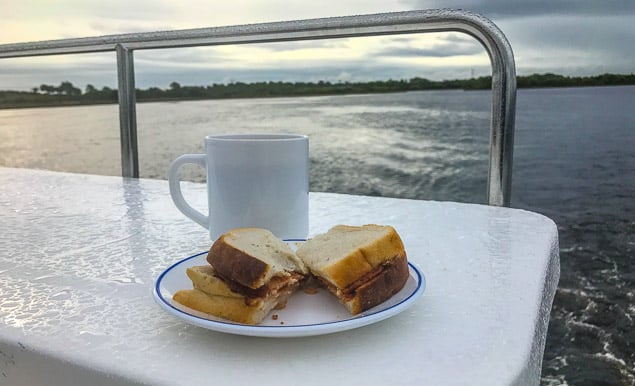 Is there any finer way to enjoy a rasher sandwich than with a nice cup of tea sauntering down the Shannon, master of your own ship?
Is there any finer way to enjoy a rasher sandwich than with a nice cup of tea sauntering down the Shannon, master of your own ship?
9.30am – Breakfast as we cruise: rasher sandwiches and a hot cup of tea served on deck. Can you beat it?
10am – Pitstop at Carrick to, ahem, check the car's locked!
10.05am – (Car now locked.)
10.30am – There's a knack to this navigation thing, but it's a game for all the family as we plot our course upriver. We remember to keep the red buoys to our left and the green on our right upstream. Downstream it's the opposite, green on left and red on right.
 Every day's a school day on the river....the kids enjoyed rudiments of navigation in the well laid-out captain's handbook
Every day's a school day on the river....the kids enjoyed rudiments of navigation in the well laid-out captain's handbook
11am – Into Lough Eidin. This beautiful lake hit the headlines in 2000 when President Mary McAleese applied for planning persmission to build a lakeside house, outbuildings and a jetty here. We can see why, it's a tranquil place...just don’t scour the books looking for it by that name because it's more locally known as 'Drumharlow Lake' and it's a top fishing spot.
11.20am – Into the Boyle River.
 Navigation gets a bit tighter on the Boyle River – especially if you meet oncoming boats
Navigation gets a bit tighter on the Boyle River – especially if you meet oncoming boats
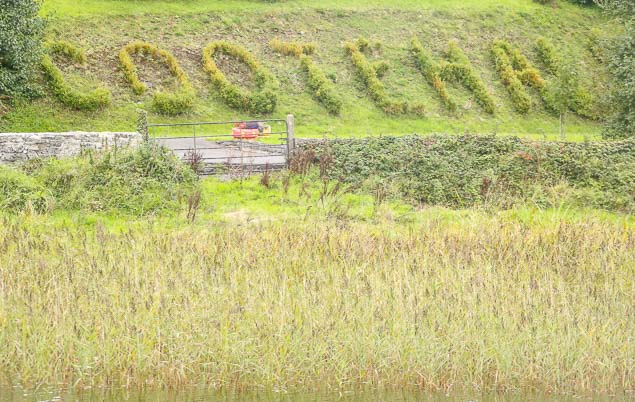 What other village has a topiary sign for its boating traffic? COOTEHALL shrubs are clipped into shape on a bend in the river
What other village has a topiary sign for its boating traffic? COOTEHALL shrubs are clipped into shape on a bend in the river
11.40am – Cootehall. What an enchanting bend in the river that invites further exploration of John McGahern's hometown, but the quay has already got boats on it. Another jetty is in a state of collapse. Sadly, we sail on.
11.50am – Oakport Lough.
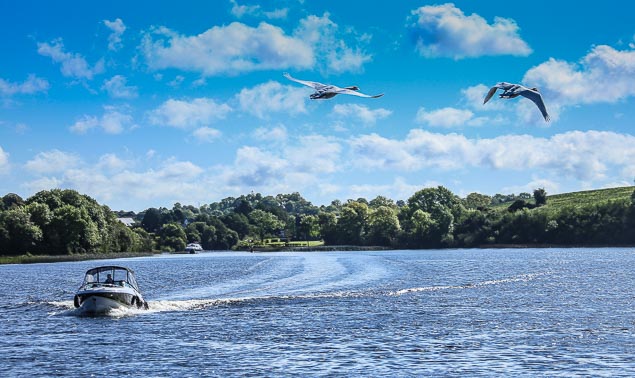 Oakport Lough is located six miles northeast of Boyle beside the village of Cootehall and known for its excellent angling. Fishing is into 10 feet of water and the lake has bream to 5 lbs, roach rudd and hybrids
Oakport Lough is located six miles northeast of Boyle beside the village of Cootehall and known for its excellent angling. Fishing is into 10 feet of water and the lake has bream to 5 lbs, roach rudd and hybrids
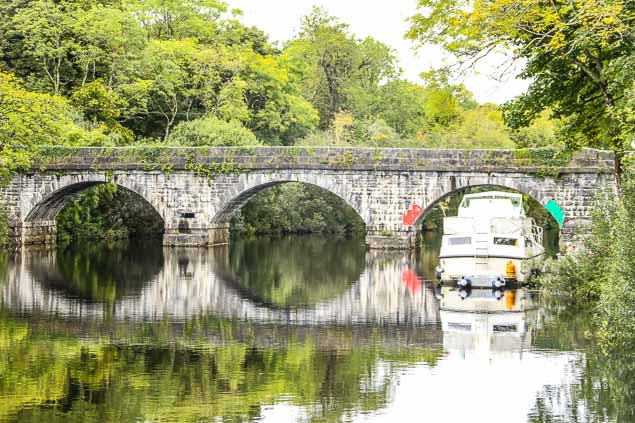 A bridge at Knockvicar. Keep to the marked navigation arch (seen here on the right) when negotiating bridges
A bridge at Knockvicar. Keep to the marked navigation arch (seen here on the right) when negotiating bridges
12 noon – We pass Knockvicar and Tara Marina and continue on the winding Boyle river.
12.30pm – Clarendon Lock, with its picturesque weir, is a very pretty Shannon setting.
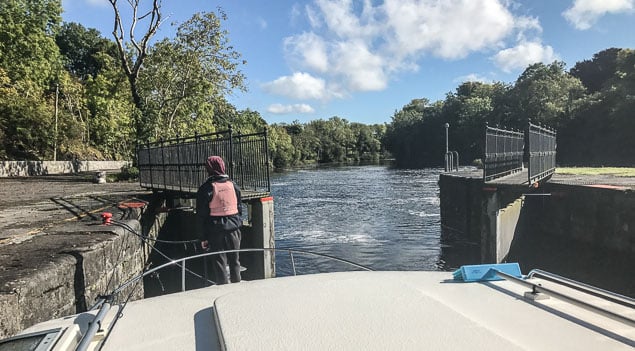 Clarendon Lock at Knockvicar is the only lock on the Boyle River. Thomas is in charge of the bow rope, while Isabel is on stern rope duty
Clarendon Lock at Knockvicar is the only lock on the Boyle River. Thomas is in charge of the bow rope, while Isabel is on stern rope duty
 After the narrow navigating up the Boyle River the magic of Lough Key awaits Courtesy: Shannon Leisure Development Company Ltd
After the narrow navigating up the Boyle River the magic of Lough Key awaits Courtesy: Shannon Leisure Development Company Ltd
12.35pm – Call from Seamus in Bike Trails: "Are ye still coming?" "See ya in 40 minutes, Seamus."
 Shannon cruisers enter Lough Key – September is a popular month on the Lough
Shannon cruisers enter Lough Key – September is a popular month on the Lough
12.50pm – We spot The Moorings restaurant and a handy adjacent marina. Could this be a lakeside dining detour tonight?
 This restaurant looked like a lovely spot but there's no where nearby to park unless you're a berth holder at a nearby marina
This restaurant looked like a lovely spot but there's no where nearby to park unless you're a berth holder at a nearby marina
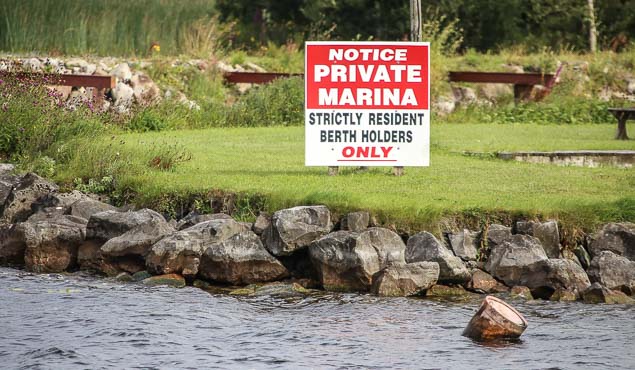
1pm – Making our way across the lough, we pass several small islands, then it's a 90 degree left for our overnight berth. It's like we've sailed into a scene from Lord of the Rings with forests, islands, castles and turrets on every headland!
 There is reference to Castle Island in the annals of 'Lough Ce' as early as 1184. During this time the park was called Moylurg and the Kings of Moylurg were the McDermotts. The McDermott’s official residence was on The Rock, now called Castle Island
There is reference to Castle Island in the annals of 'Lough Ce' as early as 1184. During this time the park was called Moylurg and the Kings of Moylurg were the McDermotts. The McDermott’s official residence was on The Rock, now called Castle Island
1.10pm – Mooring at Lough Key Forest Park Marina.
 The 50–berth marina has all the facilities to go with it, including a shower block. But you need a smart card to access it
The 50–berth marina has all the facilities to go with it, including a shower block. But you need a smart card to access it
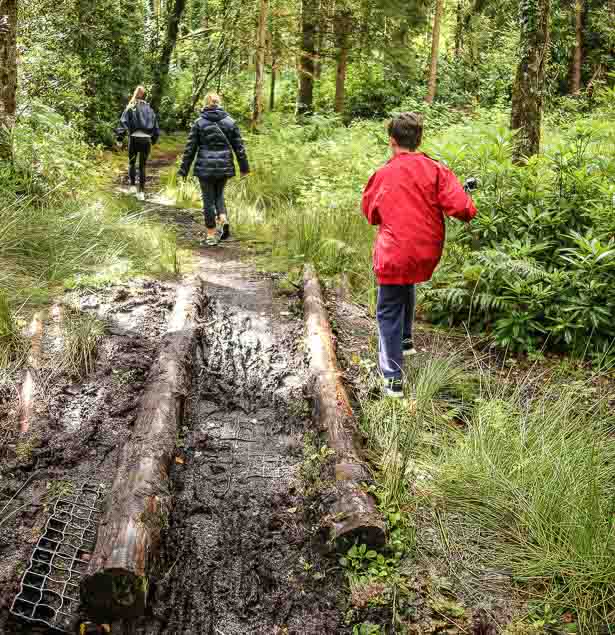 Some great forest trails
Some great forest trails
1.45pm – We saddle up with Seamus and we're on our way on an 8km bike trail.
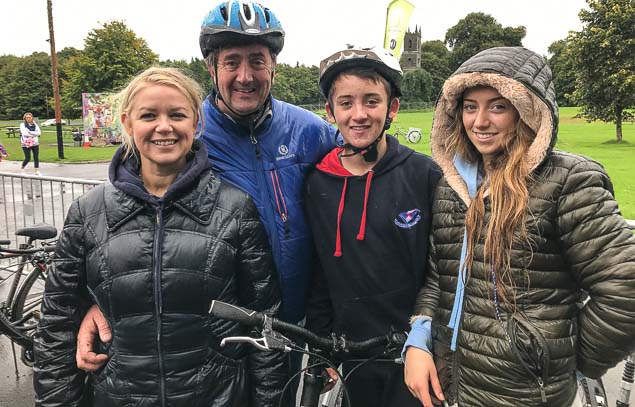 Hiring bikes is convenient at Lough Key. We hired four on site at €30 for an hour or so. The cycle trail is well suited to families with kids bikes, bikes with child seats or tag-a-longs. As these trails are completely traffic-free, they are a great place to teach your children to cycle and grow their confidence on a bike. There are approximately 8km of traffic-free trails in the park
Hiring bikes is convenient at Lough Key. We hired four on site at €30 for an hour or so. The cycle trail is well suited to families with kids bikes, bikes with child seats or tag-a-longs. As these trails are completely traffic-free, they are a great place to teach your children to cycle and grow their confidence on a bike. There are approximately 8km of traffic-free trails in the park
3pm – What a ride! Tummies rumbling, we're ready for a snack at the Woodland Cafe.
4pm – Time for an afternoon nap on board for some, a spot of fishing for others. And is there time for Zipit? Certainly.
 Feelings of trepidation as you climb and swing from tree to tree on the Zipit line
Feelings of trepidation as you climb and swing from tree to tree on the Zipit line
6.45pm – We take the Ranger Service for the 3km shuttle into Boyle. We're the only passengers.
 The Ranger timetable
The Ranger timetable
 Efforts are being made to connect local moorings at Lough Key and the Boyle Marina with the town. A 15–minute run into town on the Ranger Shuttle costs just €1 per head. Our driver gave us a guided tour too!
Efforts are being made to connect local moorings at Lough Key and the Boyle Marina with the town. A 15–minute run into town on the Ranger Shuttle costs just €1 per head. Our driver gave us a guided tour too!
6.55pm – Our bus driver points out Chris O'Dowd's family home. We're closing in on Moone Boy now!
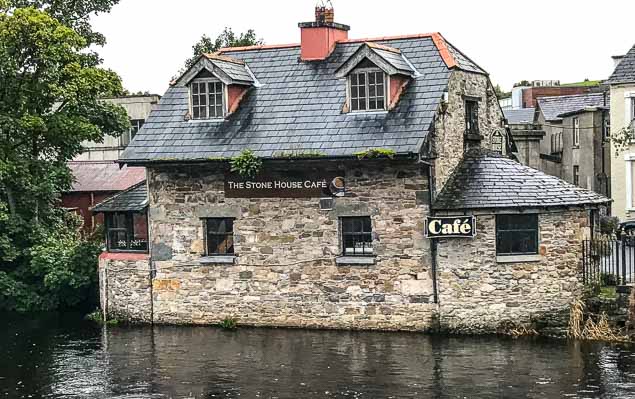 Boyle is a large, modern town with a rich history, much of it centred around the King family, one of the wealthiest families in 17th-century Ireland. Boyle is keen to make more of its riverside location but this is limited because moorings are located well outside of the town
Boyle is a large, modern town with a rich history, much of it centred around the King family, one of the wealthiest families in 17th-century Ireland. Boyle is keen to make more of its riverside location but this is limited because moorings are located well outside of the town
7pm – We arrive in Boyle and pick up supplies at Londis on the hill. Oops, forgot the carrier bag! But the shop owner offers to drive us back to the boat. It's typical of the warm welcome here.
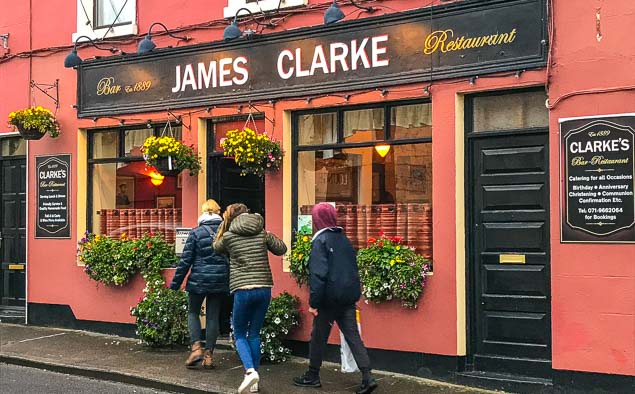
7.05pm – We head to Clarke's Bar and Restaurant in search of the 'Moone Boy Burger'.
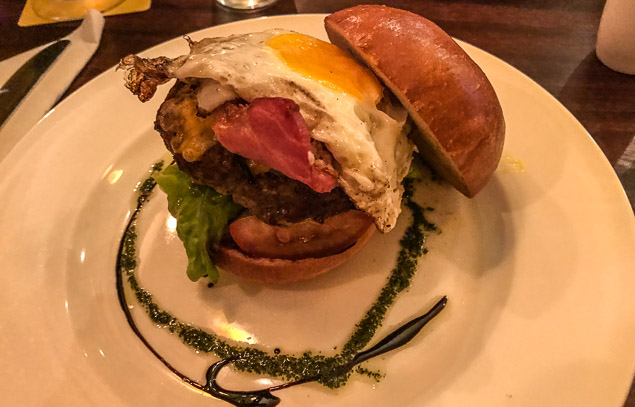 The Moone Boy Burger (It's got an egg on top) – we eventually found this massive patty at James Clarke's authentic Irish pub in Boyle town. It's not the only thing we got – there was a great welcome for boaters here, too
The Moone Boy Burger (It's got an egg on top) – we eventually found this massive patty at James Clarke's authentic Irish pub in Boyle town. It's not the only thing we got – there was a great welcome for boaters here, too
9.45pm – Waiting for the return shuttlebus at King House.
10pm – We arrive back at Lough Key Marina. Still the only passengers.
10.05pm – Back on board E22. Why can't we get this heating to work?
10.06pm – Brrr! Night, night!
Sunday - Downstream to Carrick–on–Shannon (and Dun Laoghaire)
8am – A spot of early morning fishin'?
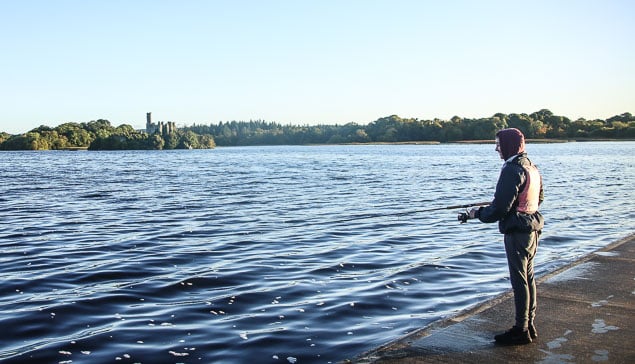 Early morning spinning. We read that September is a great month for Pike but try as we might, there was not a sign. 'That's why it's called fishin' and not catchin', I tell Thomas...
Early morning spinning. We read that September is a great month for Pike but try as we might, there was not a sign. 'That's why it's called fishin' and not catchin', I tell Thomas...
9am – Feeding the ducks as we wait for the onsite cafe to open.
10am – Breakfast toasties in hand, we're heading for downstream for home.
10.05am – Across Lough Key in autumn sunshine.
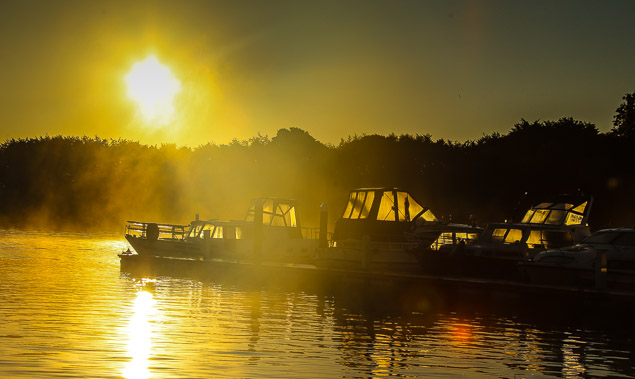
11.40am – Back in Cootehall – and now there's a free quayside berth! Take it!
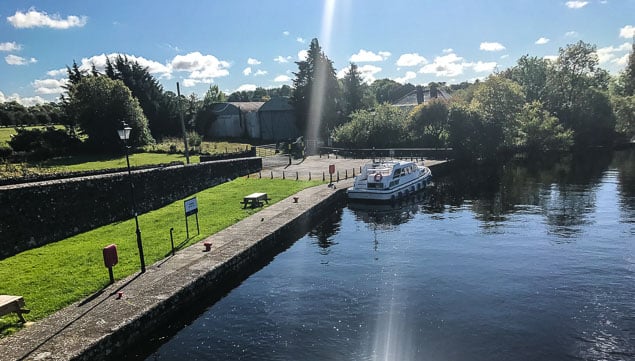 On a bend in the Boyle River, yet another picturesque spot appeared in front of us – except when we went ashore, we found it deserted.
On a bend in the Boyle River, yet another picturesque spot appeared in front of us – except when we went ashore, we found it deserted.
12 noon – We hop ashore to explore. The door is locked at McHenry's. Everyone's at Mass....
 Even MJ Henry's was locked up. The only telltale sign of life was a community notice board with a plea from locals for 'a bustling riverside village for boaters on the Lough Key route'
Even MJ Henry's was locked up. The only telltale sign of life was a community notice board with a plea from locals for 'a bustling riverside village for boaters on the Lough Key route'
 Riverside tribute: Cootehall was home to John McGahern, one of the most important Irish writers of the latter half of the 20th century
Riverside tribute: Cootehall was home to John McGahern, one of the most important Irish writers of the latter half of the 20th century
12.10pm – Back aboard cruiser E22.
12.2pm – Enter Lough Eldin. A pair of swans take flight and fly alongside us for seemingly ages. Even enough time to grab the camera. It edges out yesterday's kingfisher as the wildlife highlight of the trip.
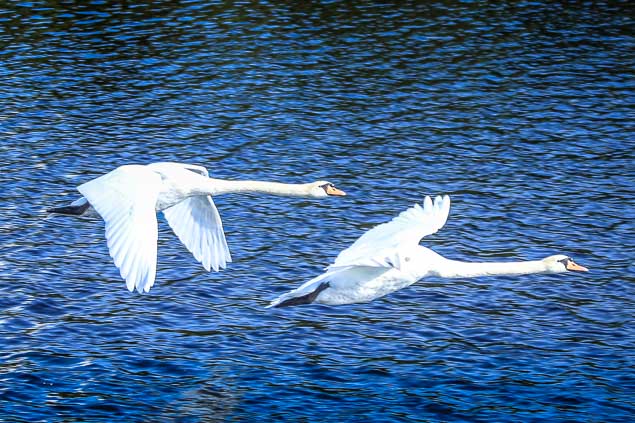
13.30pm – Return to Carrick-on-Shannon Marina, leaving E22 as we found her.
 Thanks for the memories, E22!
Thanks for the memories, E22!
4pm – We arrive home in Dublin. Time for homework and school in the morning...
What's the verdict?
Writing in the Sunday Times recently, columnist India Knight described how a friend holidayed just 40 minutes from where she lived. She concluded that the things we love doing are often familiar – and close to home. This Shannon trip proved this was also the case for us. From kingfisher spotting to tree-top advenure, this was an intrpeid voyage by our standards. We never expected to find such good times along the river, and we thoroughly enjoyed our three days afloat.
Useful links/telephone numbers:






























































